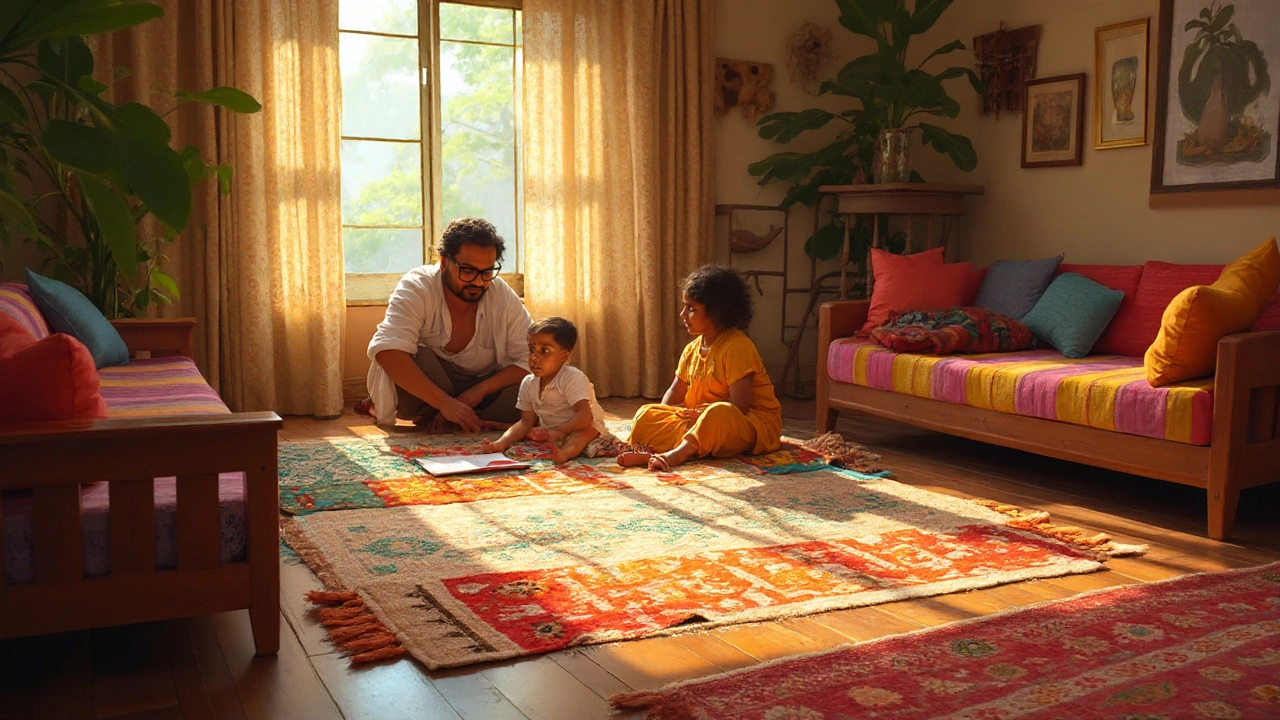Ever been in a store, locked eyes with a gorgeous rug, only to do a cartoon-style double take at the price tag? $400 for a rug can feel like ‘did someone swap those numbers?’ territory. But here’s the thing—rugs have gone from being just the thing you step on, to low-key art for your floors. And like with art, the price tag can leave you asking if you’re paying for magic threads or just some clever marketing.
Why Do Rugs Cost So Much Anyway?
If you think $400 for a rug sounds wild, you’re definitely not alone. But rugs, especially good ones, are often more complicated than they look. So what actually makes some rugs hit that price point while others barely cost more than your lunch?
First up: materials. Wool rugs cost more than synthetic ones because wool is durable, has a natural stain resistance, and ages beautifully. Silk? Gorgeous and soft, but you’ll pay for that luxury. On the flip side, synthetic fibers like polypropylene and nylon are wallet-friendly but tend to wear out sooner, mat down faster, and don’t have the same ‘oooh’ factor with aging.
Then there’s the way it’s made. Hand-knotted rugs are basically the couture of the rug world; a single piece can take months to finish because, honestly, someone’s literally tying thousands of knots herself (I once tried hand-knotting a mini rug as a DIY, and let’s just say Milly, my cat, now owns a very confused little mat). Machine-made rugs? Way faster to produce and generally run cheaper. But the tradeoff is often in the texture and depth—handmade rugs usually have a richer, denser feel underfoot.
Design complexity can seriously nudge up the price. Those rugs with lush, intricate patterns? They take a lot more time and effort to get right. Plus, brand reputation plays a part. A rug from a heritage Persian workshop is going to squeeze your bank account more than one you pick up at a chain store, because you're often paying for a unique piece with cultural weight and a story.
| Material | Typical Price Range (USD) | Durability | Cleaning Difficulty |
|---|---|---|---|
| Polypropylene (Synthetic) | $50-$250 | Medium | Easy |
| Wool | $200-$1000+ | High | Moderate |
| Silk | $500-$5000+ | Low-Medium | Difficult |
| Cotton | $100-$500 | Medium | Easy |
If you’re eco-minded, sustainable and natural dyes can also bump up the price. Handmade rugs from fair-trade cooperatives, using time-honored techniques, are often more expensive—but you know you’re supporting craftspeople and protecting the planet a little more with every footstep.
When Is $400 Actually a Good Deal?
So, is $400 worth it? Sometimes, yes. In fact, sometimes it’s a straight-up steal. The secret? It depends on the rug’s size, quality, and where it’s made.
For a mid-sized wool area rug (about 5’x8’), $400 is genuinely right in the sweet spot if you want something that’ll last. If you find a handmade wool rug at this price, it’s likely you’re getting better value than you would with a much cheaper synthetic rug you’d need to replace in a year or two. Rugs with tight knots, colorfast dyes, and thick piles hold their liveliness and softness better over time, even if Milly fancies using yours as a scratching post (guilty cat mom here).
Rug sellers often offer short-lived sales around summer or fall, and that’s when some real gems show up. Watch out for machine-made rugs masquerading as “hand-tufted” or “hand-loomed”—these can be decent, but they aren’t true hand-knotted rugs, and should cost less even at high-end stores. Ask for fabric samples or see if you can read reviews to check how past buyers feel about the rug a year out. There’s nothing worse than an online rug that looks plush in the photo and turns out to be about as soft as a doormat.
Pay attention to warranty or return policies. A store willing to back their rugs with a reasonable return window often means they’re confident about the rug’s build and longevity. Imagine spilling coffee (or in my case, Milly’s entire bowl of water) on day three—do you have options?
If you want to stretch that $400, consider natural fiber rugs like jute or sisal. They’re hardwearing and bring some earthy texture to a room, though they’re not exactly plush. Polypropylene “outdoor” rugs have also gotten shockingly stylish and durable, especially for families with kids and pets. You’ll lose some coziness, but they can save your actual floors from disaster spills and muddy paws.
Quick tip: Measure twice, buy once. It’s heartbreaking to fall for a rug that swamps your living room or, even worse, is a dinky postage stamp in the middle of the floor. Use masking tape to outline the rug size on your floor before you start browsing — it’ll instantly tell you if that $400 price tag fits the space you have (or if you’re just falling for a pretty photo online).

How to Tell If a Rug Is Worth 0
It can be hard to know what you’re getting if you’re staring at hundreds of rugs online. There’s a trick to sniffing out quality, even if you’re new to rug shopping.
- Check the pile and weight: Pick up a corner. Heaviness usually means more yarn, which translates to durability and comfort. If it flops like a pancake, it might not last.
- Inspect the back: On a hand-knotted rug, you’ll see each knot and the pattern will show through. Machine-made rugs usually have a mesh or canvas backing.
- Look for color consistency: Bleeding, uneven colors, or fuzzing can signal cheap dyes or rushed production.
- Feel the edge binding: Quality rugs have neat, tightly-stitched edges. Fraying or loose threads? Walk away.
- Think about your feet: (And your pets’ paws, too!) If the rug’s scratchy, it’ll bug you every time you walk across it barefoot or, in my case, when Milly claims it as her nap zone.
- Don’t forget about upkeep: Some expensive rugs need professional cleaning (silk especially). If that’s not in your plan, stick with wool or sturdy synthetics for low-maintenance living.
Ask the seller how the rug handles stains. Good quality rugs, even wool ones, should be able to handle a little spilled wine or muddy paw prints with a quick dab. Be slightly skeptical of “washable” claims unless there are solid reviews or videos. Jade, my friend who runs an Airbnb, swears by her set of machine-washable rugs for high-traffic areas, but she admitted her $400 wool area rug still looks the best after two years despite occasional foot traffic chaos—and resident puppy accidents.
Be mindful of the origin. Persian and Turkish rugs are known for traditional artistry and longevity. Indian, Moroccan, and Afghani rugs can also offer value and unique patterns. Take a peek, too, at artisan-made options from new makers on sites like Etsy or at local outdoor markets. Sometimes that means snagging something truly unique, not a duplicative machine-made piece from a huge catalog.
Getting the Most for Your Money: Insider Tips
Want to feel like you actually got away with a deal? Try these rug-buying hacks:
- Shop off-season: Rugs get marked down right before new stock arrives, usually late summer and after the winter holidays.
- Head to clearance corners: Big box and boutique stores often sell last-season colors or odd sizes at a major discount.
- Ask for a price match: If you find the rug cheaper at a competitor, some stores will match or beat the price.
- Negotiate with local sellers: If you’re at a flea market or independent seller, be bold and ask politely for a better deal, especially if you’re paying in cash.
- Don’t ignore pre-owned rugs: Estate sales, thrift shops, and online marketplaces sometimes have high-quality wool and Persian rugs for a fraction of the price. Just double-check for damage or strong odors if you’re shopping secondhand.
- Check for free shipping or extras: $400 might sting less if it includes a rug pad or cleaning kit.
If you’re still iffy on spending $400, start small. Buy a quality runner for your hallway or a smaller size for the bedroom. That way, you get a feel for living with it, before you commit to a bigger splurge.
Let’s be real—a rug sets the tone for a room just as much as your favorite throw pillows or a killer piece of art. Finding that sweet spot between quality, budget, and style will save you from buyer’s remorse and endless vacuuming. And maybe, just maybe, you—and your pets—can kick back and enjoy knowing your $400 floor art is money well spent.
